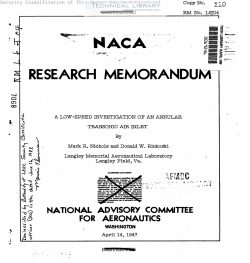naca-rm-l6j04
- Version
- 70 Downloads
- 4.58 MB File Size
- 1 File Count
- April 24, 2017 Create Date
- April 24, 2017 Last Updated
National Advisory Committee for Aeronautics, Research Memorandum - A Low-Speed Investigation of an Annular Transonic Air Inlet

A special problem is encountered. in'the' application of fuss-
lage scoops to a trensonic airplane in that compression shocks
must be avoided on the surface of the fuselage ahead of the air
inlets to prevent boundary-layer separation which would result in
unstable inlet flow and losses in ram. However, subsonic flow can
be mintained on the fuselage surface ahead of an annular inlet
up to flight Mach numbers of about 1.2, thereby avoiding shocks
in this region through both the subsonic and the transonic flight
regimes, providing that the fuselage forward. of the inlet is a
cone of the proper proportions. The present investigation of this
type of inlet was conducted at low speeds in the Langley propeller—
research tunnel in order to obtain some indication of the basic
characteristics of such inlets.
Two theoretically-designed cone-type fuselage noses of dif-
ferent apex angle and one ogival nose were tested in construction
with an NACA. 1—85-050 cowling which was also tested in the open-
nose condition. Surface pressures and inlet total pressures
were measured at the tops of the test configurations for wide
ranges of inlet-velocity ratio and angle of attack.
The results of the investigation show that substream
velocities were maintained on the three fuselage noses over the
ranges of angle of attack and inlet-velocity ratio useful for
high—speed. flight. At an angle of attack of 0°, boundary-layer
separation from the noses was not encountered over this range of
inlet-velocity ratio. At and above its design inlet—velocity
ratio, the I‘IACA 1—85—050 cowling used as the basic inlet had
approximately the same critical Mach numbers with the various
noses installed as when tested in the open-nose condition; thus,
data for the NACA l-series nose inlets can be used in the design
of installations of this type. At very high values in inlet—
velocity ratio, the high negative pressure peaks encountered on
the inner portion of the inlet lip caused the internal flow to
separate.
The use of fuselage scoops offers several important advan~
tages in the arrangement of a fighter-type airplane First, the
ducting to the engine may be made as short as possible; second,
good visibility may be obtained by locating the pilot ahead of the
inlets in a thin section of the fuselage; third, the gun installa-
tions may be located in the nose where they will not interfere with
the air inlets or ducting; and fourth, the directional stability
may be improved by reducing the lateral area forward of the center
of gravity.
| File | Action |
|---|---|
| naca-rm-l6j04 A Low-Speed Investigation of an Annular Transonic Air Inlet.pdf | Download |

Comment On This Post